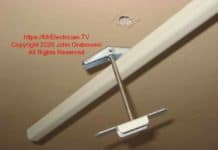Dear Mr. Electrician, How do I find a wall stud?
Answer: The methods I use to find a wall stud were learned before the invention of electronic stud finders. We used other, less technical means to find a wood stud in a wall or a ceiling joist above.
NOTE: Some text links below go to applicable products on Amazon. As an Amazon Associate, I earn from qualifying purchases. Using my links helps to keep this website FREE.
Table of Contents:
- Measuring
- Finding Wall Studs using Electrical boxes
- Using Magnets to Find a Wall Stud
- Probe For a Wall Stud
We identified the locations of the studs mostly to confirm hollow wall spaces and for attaching electrical boxes when installing wiring inside existing finished walls.
MEASURING TO FIND WALL STUDS
In most cases, residential wall studs are 16″ apart on-center (Approximately 14.5″ in-between studs). However, some residences have their wall studs spaced at 24″ on-center. Regardless, there is always a wall stud four feet from the corner of the wall.
This is because wall coverings such as drywall, plywood, and paneling are four feet wide. When installed, the drywall edges must land on a stud to be stable and have something to fasten to.
So I would measure four feet from the wall corner and then measure 16″ to each stud.
To confirm a stud where my measuring said there was, I would hold my lit flashlight against the wall while shining the beam across the finished surface to look for nails starting to come out (Nail pops) or dimples where the drywall mud or joint compound wasn’t evenly applied. This usually doesn’t work for walls and ceilings that have been plastered.
ELECTRICAL BOXES
Another method of finding a wall stud is to remove the wall plate on an electrical receptacle or wall switch and see which side of the electrical box is mounted to the wall stud. I can then measure 16″ from there.
I can also insert a fish tape or a thin screwdriver alongside the electrical box to probe inside the wall to find a stud.
MAGNETS
A magnet can also help find a wall stud inside the wall. If you gently move the magnet up, down, and across the wall, you will feel the magnet stick to a nail head.
I had a small, powerful magnet on a string that I would dangle along the surface of a wall until it stuck.
I don’t own one, but I suppose a metal detector could be used to locate the nails in a wall.
PROBING
Some people like to confirm that they found a wall stud where they want it by inserting something long, thin, sharp, and stiff into the wall close to the floor or baseboard. A thin awl works or a short piece of fish tape without a hook.
A sharpened coat hanger may work, but the metal is soft and bends easily. Tapping a finish nail with a hammer into the wall at floor level would also confirm a stud’s presence. However, If you are too close to the floor when doing this, your nail or fish tape may come in contact with the bottom plate instead of a wall stud. This can be approximately 1.5″ high from the floor.
Locating a few studs to confirm they are sixteen inches apart is best. Sometimes, there are double, triple, or quad studs depending on the load-bearing characteristics of the wall.
After finding the wall stud location, to determine where to install an electrical box, make a tiny hole in the center of the new electrical box location before cutting an opening in the wall. Insert a short fish tape, a coat hanger wire, or a very long thin screwdriver into the hole and probe in all directions to feel for possible obstacles. After that, insert a longer fish tape up and down the wall to check for other blockages in the wall cavity.
If there is an attic and basement, it may be possible to locate the top and bottom of the walls and see if any pipes, wires, or air ducts are going up or down inside the wall. This can be a little tricky. Good measuring is necessary when finding a wall stud, especially if you plan to drill up or down into the wall cavity.
A drill bit popping up through the floor is not good. You may need to identify landmarks such as a chimney, air supply vent, or an electrical outlet in the wall to help locate a position in the basement or attic.
By doing all this, you should confirm that the area where you want to install something in the wall is clear of wall studs and other obstacles, such as air ducts, water pipes, and gas pipes. Although wires in the wall can be an obstacle, sometimes they can be pushed aside to make room for an electrical outlet or switch box.
Ideally, your new electrical box installation should be alongside a wall stud. That way, you can use a sheet metal screw through the box to secure it to the stud so that it is not relying entirely on the drywall for support.
There are photos of this in several of my articles. See this one here.
Click to see all of my articles about old-work house wiring.
To help keep this website FREE, please use this Amazon link for your purchases. As an Amazon Associate, I earn from qualifying purchases.
Click for a FREE copy of my book “Almost Everything You Need To Know To Repair a Bathroom Exhaust Fan In Your Home.”
Get your required “Emergency Disconnect, Service Disconnect” labels and stickers to satisfy the 2023 National Electrical Code requirements in article 230.85(E)(1) by going to my shop here.
Visit my Link Tree for links to my social media and merchandise.
Here’s a link to another website that can help you find wall studs.










